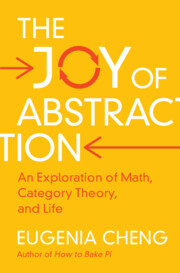Refine search
Actions for selected content:
3286 results in Quantum Physics, Quantum Information and Quantum Computation
13 - Why Quantum Mechanics?
-
- Book:
- Quantum Mechanics
- Published online:
- 14 January 2023
- Print publication:
- 15 December 2022, pp 337-344
-
- Chapter
- Export citation
4 - Axioms of Quantum Mechanics and their Consequences
-
- Book:
- Quantum Mechanics
- Published online:
- 14 January 2023
- Print publication:
- 15 December 2022, pp 58-88
-
- Chapter
- Export citation
C - Further Reading
-
- Book:
- Quantum Mechanics
- Published online:
- 14 January 2023
- Print publication:
- 15 December 2022, pp 354-355
-
- Chapter
- Export citation
9 - The Hydrogen Atom
-
- Book:
- Quantum Mechanics
- Published online:
- 14 January 2023
- Print publication:
- 15 December 2022, pp 201-240
-
- Chapter
- Export citation

The Joy of Abstraction
- An Exploration of Math, Category Theory, and Life
-
- Published online:
- 13 October 2022
- Print publication:
- 13 October 2022
9 - Examples we’ve already seen, secretly
- from Interlude - A Tour of Math
-
- Book:
- The Joy of Abstraction
- Published online:
- 13 October 2022
- Print publication:
- 13 October 2022, pp 111-116
-
- Chapter
- Export citation
Contents
-
- Book:
- The Joy of Abstraction
- Published online:
- 13 October 2022
- Print publication:
- 13 October 2022, pp ix-xiv
-
- Chapter
- Export citation
15 - Monics and epics
- from Part Two - Doing Category Theory
-
- Book:
- The Joy of Abstraction
- Published online:
- 13 October 2022
- Print publication:
- 13 October 2022, pp 186-205
-
- Chapter
- Export citation
23 - Yoneda
- from Part Two - Doing Category Theory
-
- Book:
- The Joy of Abstraction
- Published online:
- 13 October 2022
- Print publication:
- 13 October 2022, pp 351-367
-
- Chapter
- Export citation
Further Reading
-
- Book:
- The Joy of Abstraction
- Published online:
- 13 October 2022
- Print publication:
- 13 October 2022, pp 416-417
-
- Chapter
- Export citation
1 - Categories: the idea
- from Part One - Building up to Categories
-
- Book:
- The Joy of Abstraction
- Published online:
- 13 October 2022
- Print publication:
- 13 October 2022, pp 13-22
-
- Chapter
-
- You have access
- Export citation
Appendix D - Background on topological spaces
- from Appendices
-
- Book:
- The Joy of Abstraction
- Published online:
- 13 October 2022
- Print publication:
- 13 October 2022, pp 407-409
-
- Chapter
- Export citation
3 - Patterns
- from Part One - Building up to Categories
-
- Book:
- The Joy of Abstraction
- Published online:
- 13 October 2022
- Print publication:
- 13 October 2022, pp 35-43
-
- Chapter
- Export citation
Appendix C - Background on set theory
- from Appendices
-
- Book:
- The Joy of Abstraction
- Published online:
- 13 October 2022
- Print publication:
- 13 October 2022, pp 405-406
-
- Chapter
- Export citation
Glossary
-
- Book:
- The Joy of Abstraction
- Published online:
- 13 October 2022
- Print publication:
- 13 October 2022, pp 410-415
-
- Chapter
- Export citation
10 - Ordered sets
- from Interlude - A Tour of Math
-
- Book:
- The Joy of Abstraction
- Published online:
- 13 October 2022
- Print publication:
- 13 October 2022, pp 117-123
-
- Chapter
- Export citation
Part One - Building up to Categories
-
- Book:
- The Joy of Abstraction
- Published online:
- 13 October 2022
- Print publication:
- 13 October 2022, pp 11-12
-
- Chapter
- Export citation
Acknowledgements
-
- Book:
- The Joy of Abstraction
- Published online:
- 13 October 2022
- Print publication:
- 13 October 2022, pp 418-419
-
- Chapter
- Export citation
11 - Small mathematical structures
- from Interlude - A Tour of Math
-
- Book:
- The Joy of Abstraction
- Published online:
- 13 October 2022
- Print publication:
- 13 October 2022, pp 124-135
-
- Chapter
- Export citation
6 - Formalism
- from Part One - Building up to Categories
-
- Book:
- The Joy of Abstraction
- Published online:
- 13 October 2022
- Print publication:
- 13 October 2022, pp 67-81
-
- Chapter
- Export citation
